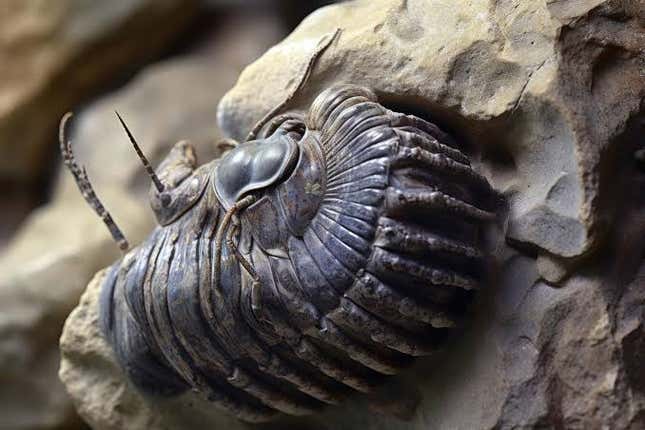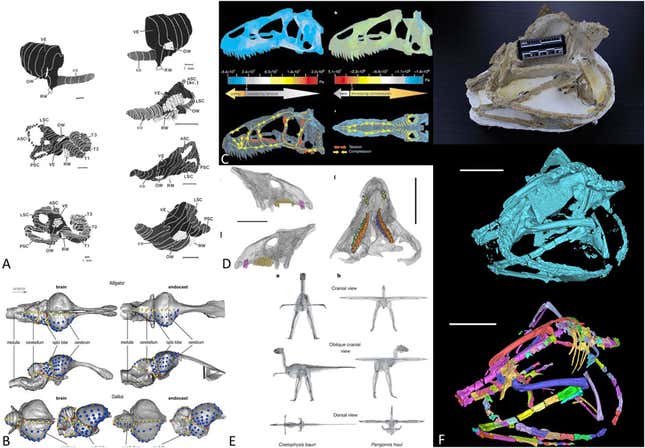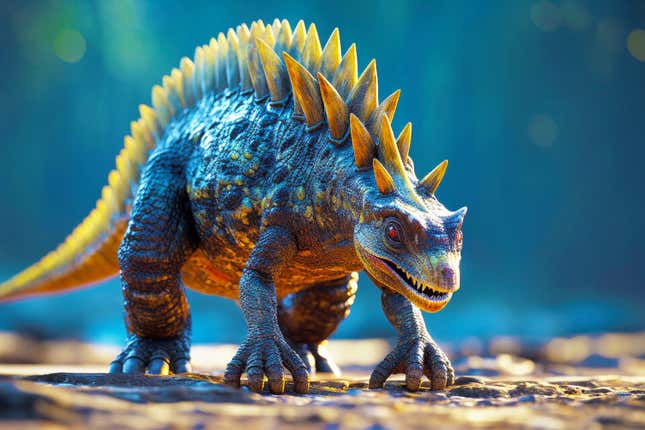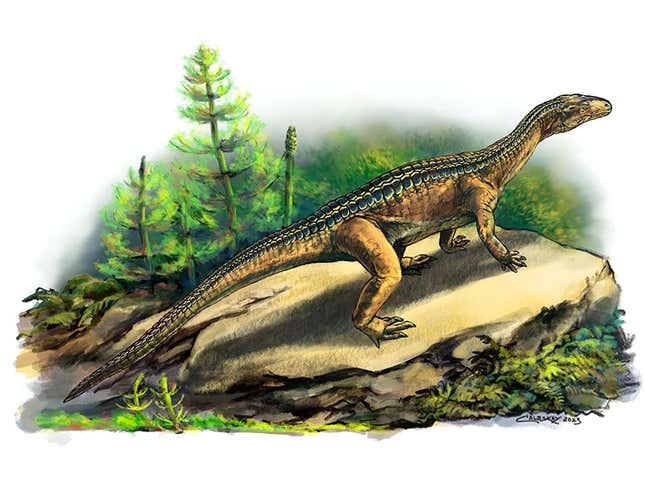A rat with not less than 4 testicles, one bigger than its head, published in a scientific journal earlier this yr. A pterosaur with a third foot sprouting from its wing. A museum posting a psychedelic Godzilla-meets-gecko on social media, whereas a extra life-like illustration of the traditional reptile seems on its website.
Imagery produced by synthetic intelligence has caused its fair share of controversy. The handful of leading image generators aren’t excellent and yield outcomes which are generally divergent from the person’s wants or expectations. However within the sciences, AI fashions are greater than instruments for making media or springboards for creativity. They’re contributors to the scientific file, inasmuch because the figures in scientific analysis are part-and-parcel to the staff’s written findings.
What’s ‘paleoart’?
In paleontology, the science-informed depictions of historic creatures—often known as “paleoart”—assist different scientists and the general public make that means from new findings. They’re grounded in science and are a novel portal into worlds tens, and generally a whole bunch, of hundreds of thousands of years faraway from us. In that manner, there’s way more in danger than the yassification of Mary Anning.
Paleoart occupies a novel house within the science communication ecosystem by advantage of its topics. Illustrators are tasked with depicting long-extinct animals in accordance with trendy scientific understandings of that animal: what it regarded like, in fact, but additionally the atmosphere through which it lived, and the way it made use of that atmosphere.
“I take into account palaeoart to be inventive reconstructions of prehistoric creatures utilizing an knowledgeable strategy, as correct as will be, and with justified choices,” mentioned Jacob Blokland, a paleontologist and paleoartist at Flinders College in Australia, in an electronic mail to Gizmodo. “This will imply ranging from the bones-up, making use of muscle groups, researching what sort of soppy tissues it might need had, concerns of posture, phylogenetic brackets, potential atmosphere, and so forth., all from the literature or the identified materials accessible.”
The illustrations are impressed by trendy animals which are both evolutionarily associated to the extinct organisms or occupy related ecological niches to the traditional creatures. Relying on the prompts they’re given, AI picture mills aren’t presently able to intaking this complicated and various data and producing a picture from it with the identical constancy and a spotlight to element as a human artist.
“Illustrating with out concerns of those isn’t precise palaeoart for my part, however somewhat impressed by it,” Blokland added. “I feel ‘palaeoart’ on this sense continues to be very a lot a factor distinctive to non-AI illustrators.”
The scientific course of behind paleoart
Take into account dinosaur pores and skin. It hardly ever preserves, and when it does, there’s no assure that researchers will be capable to discern particulars like pigmentation from the fossilized cells— although a team was able to do just that with a dinosaur cloaca again in 2021. Regardless of this, it’s price noting that ChatGPT instructed me that, “As of my final replace in January 2022, there hasn’t been any fossil proof of a dinosaur cloaca found.” In different phrases, all the time double-check data from AI chatbots!
That sort of uncertainty about gentle tissue leaves a lot to the creativeness: how do we all know the coloration of dinosaurs, or which of them had plumage? When paleontologists are making choices on whether theropod dinosaurs like T. rex had lips or not, it’s as much as paleoartists to precisely signify what they could have regarded wish to an keen public.
Briefly: The quantity of effort dedicated to a scientific paleoart illustration could also be misplaced on the common viewer. It’s not merely an outline of a given extinct animal in some believable setting, however somewhat a cutting-edge imagining of the animal and its environs based mostly on the huge quantity of paleontological, zoological, musculoskeletal, biomechanical, morphological, and evolutionary data developed through the years.
“The saddest factor about AI artwork is that one thing like paleoart has a human contact to it,” mentioned Natalia Jagielska, a paleoartist and the collections officer at Lyme Regis Museum in England, in a video name with Gizmodo. “Paleoart is scientific—nevertheless it’s nonetheless artwork, it’s self-expression.”
Paleoart from folks of various backgrounds will seem otherwise, Jagielska provides, as a result of all of us see the world and its animals otherwise. AI fashions are machines and thus not able to taking lived expertise or private perspective into consideration when producing paintings. The rise of AI-generated paleoart prompted the #PaleoAgainstAI hashtag on X, previously referred to as Twitter, via which paleoart illustrators and supporters spoke up for human representations of historic creatures over computer-generated ones.
Questionable ethics
When AI is utilized in paleo-reconstructions, PBS Standards emphasizes that AI-generated media needs to be disclosed as such and may preserve the requirements of accuracy and inclusivity anticipated of every other editorial product. Even when the usage of AI in creating paleo-media (we’re making {that a} time period) is disclosed and meets present scientific requirements, some argue that AI is taking away the work of actual paleoartists and mustn’t have a task in paleontology.
“Picture generative AI is an algorithm for copyright theft,” mentioned Per Ahlberg, a paleontologist at Uppsala College in Sweden, in a video name with Gizmodo. “What’s even worse is you could then use this to start out driving the folks whose work you will have stolen and integrated into your studying algorithm out of enterprise, and it is a main downside as a result of we have to paleoartists—actual ones.”

AI-generated paleoart is “a straight up deception of the studying public,” Ahlberg added, “and it’s spitting within the face of a conventional paleoart, which has had a serious function in serving to us to conceptualize previous worlds and their inhabitants.”
AI has many helpful functions throughout the sciences
Regardless of its misuse in paleoartistry—by media outfits, but additionally establishments and even scientists—synthetic intelligence has huge utility within the sciences for redefining the best way we see our world and the universe. Already, it’s altering the ways astronomers scan the cosmos for fascinating phenomena and allowing archaeologists to read ancient scrolls which are in any other case too fragile to study.
AI is a boon to fields that require sifting via terabytes of knowledge and can nearly definitely velocity up the speed at which scientific discoveries are made. Even in paleontology, deep neural networks—a sort of multi-layered neural community that may determine patterns and make predictions and choices—are used to segment CT-scans of dinosaur fossils, chopping down the time spent manually processing them. AI has additionally been utilized in paleontology to categorize types of single-celled plankton and speciate grains of pollen within the fossil file, a laborious activity for the human eye.

“The place I do have substantial issues—and I can see it occurring all too simply, simply on the premise of regular human laziness—is the place folks outsource the analytical stage to the AI,” Ahlberg mentioned, “such that in the long run, the human writer is principally saying, ‘effectively, I don’t fairly perceive how the AI can outline these patterns, however I belief the black field.’”
“At that time, you actually deserted the core level of science,” he added.
Looking for pointers for moral AI
In an editorial published final month within the Proceedings of the Nationwide Academy of Sciences, a handful of scientists emphasised the immense potential of AI within the sciences, however proposed 5 rules to information researchers in its use: clear disclosure and attribution, verification of AI-generated content material and analyses, documentation of AI-generated information, a deal with moral and equitable pointers for AI’s use, and steady monitoring of AI’s impression within the scientific course of, with involvement from the general public.
In a release accompanying the editorial, the geophysicist, examine co-author, and Nationwide Academies president Marcia McNutt mentioned: “We welcome the advances that AI is driving throughout scientific disciplines, however we additionally should be vigilant about upholding long-held scientific norms and values.”
Although paleoart isn’t topic to the identical degree of rigor as peer-reviewed journal articles, it’s a essential part of the communication round scientific analysis. As such, AI’s use in visible scicomm ought to warrant an analogous degree of rigorous evaluate.
“On the velocity with which these AI engines are evolving, and if there isn’t any laws put in place to manage them, they may turn out to be higher and they’ll finally threaten the work of paleoartists,” mentioned Gabriel Ugueto, a scientific illustrator and paleoartist, in an electronic mail to Gizmodo. “Should you worth the accuracy of the knowledge we give to the general public, it’s time to be accountable.”
AI continues to be not superb at this
Although AI’s utility within the sciences has yielded loads of new discoveries, and undoubtedly will yield many extra, it has its pitfalls. The “rat dck” fiasco uncovered the difficulties AI picture technology software program can have with scientific illustrations and figures, but additionally highlighted the necessity for extra guardrails in peer-reviewed journals. A spokesperson for Frontiers, the household of journals through which the rat examine was revealed, instructed Gizmodo that the “substandard figures and annotations” had been revealed “regardless of processes in place to make sure compliance.” One of many paper’s reviewers told Vice that the wrong imagery of the rat and its related testes was not their accountability.

Whereas many may discern the farcical bits of the rat picture, it may be more durable for the general public to see scientific inaccuracies in depictions of historic animals. Paleoartists present the general public’s greatest glimpse at how creatures eked out existence hundreds of thousands of years in the past in a extra vibrant manner than any skeleton can.
“The appreciable quantity of information and proof that goes into true palaeoart reconstructions produces a outcome much more correct than what AI artwork can obtain,” mentioned Phoebe McInerney, a paleontologist at Flinders College, in an electronic mail to Gizmodo.
As they presently exist, AI-generated photographs typically misrepresent the creatures paleontologists and illustrators work arduous to deliver to life (although they’ve improved considerably within the final couple of years). The visible communication of historic life is vital: The T. rex that sticks in a younger thoughts after a go to to the museum is that of the large, ferocious predator, not the exhaustively reviewed written materials about its morphology and taxonomic id on an exhibit placard. It’s one factor to play with an AI picture generator your self to make a cross between a hen and a T. rex, nevertheless it’s a unique matter fully when an establishment or media outlet presents the general public with a scientifically inaccurate depiction of life that contradicts peer-reviewed analysis.
Gizmodo reached out to 2 researchers and one museum that beforehand shared AI-generated imagery of historic creatures in affiliation with revealed analysis; one researcher declined to remark and the opposite two didn’t reply at time of publication.
AI poses different dangers if misused, and a few are combating again
Final yr, researchers from Northwestern College discovered that human reviewers were unable to differentiate educational abstracts written by OpenAI’s ChatGPT from human-written abstracts, regardless of being instructed that a few of the analysis they might evaluate was AI-generated.
AI-generated illustrations are right here to remain, however these mills can’t produce true paleoart: inventive creations full of scientific that means and nuance. Packages just like the College of Chicago’s Nightshade are designed to “poison” generative AI fashions that try to coach on a given picture and a few paleoartists deploy the software program to guard their media from being scraped by AI.
It doesn’t matter what particular person illustrators do, the positions establishments tackle artificially-generated imagery may have a extra substantial impression on the best way the expertise is utilized in depicting scientific data. AI is right here to remain and that’s a very good factor for science. However a set of rules outlining AI’s use in science communication is vital for not solely figuring out correct use instances, however for sustaining folks’s belief in science. Communication is vital, and at a minimal the general public deserves to know what they’re .
Extra: These 13 Images Depict the Most Realistic CGI Dinosaurs Ever
Trending Merchandise

Cooler Master MasterBox Q300L Micro-ATX Tower with Magnetic Design Dust Filter, Transparent Acrylic Side Panel, Adjustable I/O & Fully Ventilated Airflow, Black (MCB-Q300L-KANN-S00)

ASUS TUF Gaming GT301 ZAKU II Edition ATX mid-Tower Compact case with Tempered Glass Side Panel, Honeycomb Front Panel, 120mm Aura Addressable RGB Fan, Headphone Hanger,360mm Radiator, Gundam Edition

ASUS TUF Gaming GT501 Mid-Tower Computer Case for up to EATX Motherboards with USB 3.0 Front Panel Cases GT501/GRY/WITH Handle

be quiet! Pure Base 500DX ATX Mid Tower PC case | ARGB | 3 Pre-Installed Pure Wings 2 Fans | Tempered Glass Window | Black | BGW37

ASUS ROG Strix Helios GX601 White Edition RGB Mid-Tower Computer Case for ATX/EATX Motherboards with tempered glass, aluminum frame, GPU braces, 420mm radiator support and Aura Sync

CORSAIR 7000D AIRFLOW Full-Tower ATX PC Case – High-Airflow Front Panel – Spacious Interior – Easy Cable Management – 3x 140mm AirGuide Fans with PWM Repeater Included – Black











